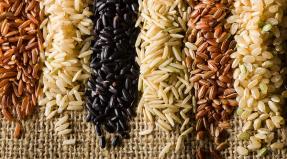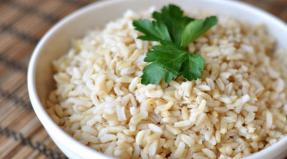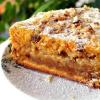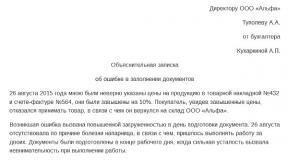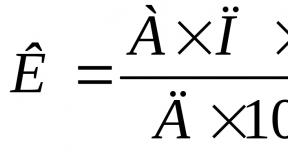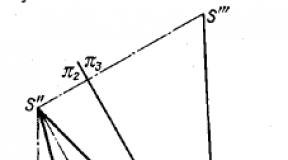History of cocoa and chocolate. Chocolate history, the benefits and harms of chocolate 1700 was first added to dark chocolate
Columbus discovered chocolate, and presented the chocolate drink in its original form Spanish king in 1528 Fernand Cortes. "Chocolatl" - a drink based on cocoa beans with the addition of pepper, honey and vanilla was made by the Aztecs and Mayans for several centuries. In Europe, sugar and milk were added to the drink to reduce the bitter taste. The drink became so popular among the Spanish nobility that, according to the decree of Charles V, the secret of making chocolate became a Spanish state secret. Only 100 years later, when marrying the daughter of King Philip Anna of Austria to King Louis XIII of France, cocoa beans were sent to Paris as a wedding gift to make this wonderful drink.
- 1659 - The first chocolate manufactory was opened in Paris: the beans were cleaned by hand,fried and ground, then the resulting mass fell out onto a stone,mixed and rolled with an iron roller.
- 1825 - chocolate was invented in the form of bars at the Mellier factory. So chocolate became availablefor general sale.In the same year, the Dutchman Konrad Johannes Vas Huten to reduce the fat content of the drinkinvented a method for extracting cocoa butter from cocoa beans. From the resulting product and cakelearned how to make cocoa powder.
- 1828 - one of the greatest discoveries in history was made Food Industry - invented a recipe for making chocolate as we know it now, that is, peoplelearned how to combine cocoa butter, cocoa powder and sugar.
- 1848 - Auguste Poulain founded his chocolate factory and invented cocoa powder.
- During the time of Marie Antoinette, a chocolate drink prepared according to her was popular.own recipe: chocolate was mixed with orchid flower powder, flowersoranges and almond milk.
- During the First and Second World WarsThe recipe brought to Europe from Venezuela was extremely popular:a mixture of chocolate, sugar and banana flour.
- Hard chocolate was first invented in England in the 17th century, and in 1831 John Cadbury beganown chocolate production, which in the twentieth century turned into one of the chocolate empires.
- In the days of Columbus and Cortes, chocolate was actually worth as much as gold.
- Indians could buy one slave for 100 seeds. America even developed chocolatecounterfeiting - since the value of the product was determined by weight, scammerslearned how to extract the beans from the pods and replace them by weight with small stones.
- "The last to know chocolate will be the first" - chocolate in the most "chocolate" countryworld - Switzerland appeared only at the end of the 17th century, and the first confectionery openedonly a hundred years later. And, nevertheless, it was the Swiss who became the most zealouschocolate aficionados in Europe.
- 1828 - Amede Kohler figured out how to make chocolate with nuts.
- 1875 - Daniel Peter developed a recipe for milk chocolate. Together with partner Henri Nestlé (who was a pharmacist by trade), they began mass-producing a mixture of chocolate and milk.
- 1868 - Jean-Paul Tobler began to produce instant chocolate in his factory. His son Theodore combined the family name and the Italian word "torrone" (honey-almond nougat) and, under the name "Toblerone", produced the now famous chocolate in the form of "curbs". And Rudolf Lindt invented chocolate with fillings and started production in Bern.
 Chocoatl ancient recipe for kings and nobility
Chocoatl ancient recipe for kings and nobility
The recipe for chocoatl, the very first cocoa drink, is not like modern chocolate recipes. Once only the elite drank, the cacao beans were roasted over a fire and then coarsely ground between stones to make this spicy drink. This produced a paste, which was then mixed with water and heated until cocoa butter appeared on the surface. The oil was removed, after which the drink was cooled and whipped until foam was formed. Chocoatl was drunk freshly prepared, with the addition of chili pepper, vanilla, cornmeal, other exotic ingredients.
 Divine power of cocoa fruits
Divine power of cocoa fruits
It was believed that the cocoa tree grew in paradise, many supernatural abilities were attributed to the chocoatl. Legend has it that whoever consumes cocoa beans becomes wise, rich and strong. Therefore, it is not surprising that cocoa was intended only for the elite of the Aztec society, who called it "black gold". Before reaching Europe in 1519, cocoa was drunk by adult men, including priests, high-ranking warriors, and sacrificial men and women.
 When money grows on trees
When money grows on trees
"Money grows on trees." These words were written by Spanish chroniclers who accompanied the conquistadors to the New World. The Aztecs really valued cocoa beans so highly that they even began to play the role of money with them. The monetary value of the beans was high. The rabbit cost - 10 cocoa beans, the slave - 100. "Kakau" was originally translated as "an offering from those who raised cattle, works and cultivates the land", which can be interpreted as an exchange or payment. Long after the disappearance of the Aztecs, as late as 1858, beans were used as money in the Central American market.
Journal of the Smithsonian Institution, cocoa beans, from which chocolate is made, were used as payment during Mayan and Aztec times. Studies show that these beans were faked by molding them from clay.
2. Chocolate was the equivalent of money in the military
5. Cocoa helps you recover faster after workouts
These are scientists from the US Department of Nutrition and Health Sciences. Cocoa helps to recover faster after sports due to the high content of protein and carbohydrates in the drink.
6. Dark chocolate is high in antioxidants.
Dark chocolate is good for heart health. It reduces arterial pressure due to the high amount of antioxidants. Daily consumption of 100 g of chocolate significantly reduces the risk of heart disease.
7. Each chocolate bar has an average of 50 mg of caffeine.
This is evidenced by data from Coca-Cola. 50 mg of caffeine is contained in one cup of espresso.
funny scientific facts about chocolate
8. The word "chocolate" comes from the Aztec word "chocolatl"
"Chokolatl" is translated as "bitter water". In those days there was no sugar, so the taste of chocolate was completely different in ancient times.
9. The scientific name of the tree that grows cocoa beans is "Food of the Gods"
The scientist Carl Linnaeus was a fan of chocolate, so in 1753 the cocoa tree was named "Food of the Gods".
10 Cocoa Was Invented In Jamaica In The Early 1700s
The cocoa drink was first made by the Irish botanist Hans Sloan in Jamaica. The locals gave him cocoa beans. He mixed them with milk to quench his thirst. And so it turned out to be cocoa.
11. There are actually four types of chocolate.
Some people think that only dark, milk and white chocolate exist. But there is also blond chocolate, which was created by accident. White chocolate contains 32% cocoa. It tastes a bit oily.

12. White chocolate is not chocolate at all.
White chocolate contains cocoa butter but no cocoa powder. This oil is not very tasty, so milk fat, vanilla and sugar are added to it.
13. Chocolate has over 600 flavors
Chocolate contains over 600 aromatic compounds, according to the American Chemical Society. For example, in red wine there are only about 200 of them.
Chocolate business
14. It takes an annual harvest of beans from one tree to produce 10 chocolate bars.
Yes, the beans from one tree are only enough for 10 chocolates.
15. Chocolate cookies were invented by accident.
American Ruth Graves Wakefield made cookies by accident in the 1930s. She wanted to serve baked goods to guests at the Toll House Inn. Instead of butter, she added chocolate. And so it became a popular delicacy.
16. The inventor of chocolate chip cookies sold the recipe for a lifetime of chocolate.
Ruth Wakefield later sold the chocolate chip cookie recipe to Nestle in exchange for a lifetime supply of chocolate.
17. The chocolate bar was invented in 1847
It was created by Joseph Fry together with his son. The first bar consisted of cocoa butter, cocoa powder and sugar.

18. The turnover of the chocolate industry is more than 75 billion dollars
This is one of the most successful industries in the world. Each year, the manufacture and sale of chocolate brings in $75 billion.
19. The most expensive chocolate in the world was sold for 687 dollars (40 thousand rubles)
It was a Cadbury chocolate bar. Its uniqueness lies in the fact that in 1901, together with Robert Scott, he was on the first American expedition to Antarctica. At the time of sale, the chocolate was 100 years old.
20. More than half of chocolate is eaten in Europe
Forbes magazine talks about it. The largest consumer countries are Switzerland, Germany and Ireland.
21. Most chocolate sold at Brussels Airport
Nothing less than 800 tons of chocolate a year!
22. Benjamin Franklin sold chocolate at a printing shop.
One of the Founding Fathers of the United States sold chocolate along with stationery and Bibles in his printing shop. It was in 1739.
23. Famous candies were called "kisses" because of the sound of cars
"Kisses" from Hershey's was named so because the machine that stamps candy makes a sound similar to a kiss.
24. Milky Way chocolate is not named after the Milky Way.
Producers of famous chocolate on their page in
Enjoying the taste of chocolate, few people ask themselves the question: where and how did chocolate appear? Meanwhile, it will be useful for chocoholics to get acquainted with information about the historical homeland of the delicacy, and interesting facts about its appearance.
The history of the origin of cocoa and the creation of chocolate
The history of the appearance of chocolate has more than 3 millennia. So who invented chocolate? The history of the appearance of chocolate dates back to the 17th century. The fruits of cocoa beans were known to the tribes of the American Indians. Then they were used exclusively for the preparation of hot drinks.
A drink based on cocoa beans was prepared with the addition of various herbs and spices. This is how the European H. Columbus recognized him. Then the traveler brought the fruits of cocoa beans to the Spanish monarch. But they did not gain popularity. And all due to the bitter and unusual taste.
The drink and the taste of cocoa beans were tasted by F. Cortes, the viceroy of the king in New Spain. He was so impressed by the unsurpassed taste of the invigorating drink that he decided to plant chocolate trees on his plantations.
Thanks to the work of Cortes, an invigorating drink based on cocoa beans became known throughout Europe. The chocolate drink was so relished that it was drunk in all noble houses. However, mere mortals could not afford such a luxury, due to the fact that the fruits were quite expensive.
Until now, we could only enjoy a fragrant and invigorating drink made from cocoa beans, if it were not for the engineer Konrad van Houten, who patented and invented the so-called hydraulic press in the early 19th century, with which oil was extracted from the fruits of the chocolate tree.
At the end of the 19th century, the first milk chocolate was produced. You can roughly imagine how much the confectionery tile cost. However, with the development of civilization, the process of producing delicacies became more accessible, which made it possible for everyone to enjoy chocolate sweets.
Today in the world there are several confectionery factories that produce high-quality and elite delicacy. Unfortunately, the composition of modern sweets, which are presented on the shelves of domestic supermarkets, cannot be called either useful or natural. Increasingly, cocoa bean oil is being replaced with cheap counterparts, such as palm or coconut oil. The best chocolate is produced in Mexico, Switzerland, Belgium and Spain.
The history of hot chocolate
It has already been noted above that the first was prepared in Mexico. True, its taste and recipe are not much like the modern version of preparing a hot drink, which includes: milk, sugar and cocoa.
In ancient times, the Indians drank the drink exclusively cold. Interestingly, the Indians considered this drink to be healing, since its use had a positive effect on male potency. It is worth noting that the liquid was consumed exclusively by men of noble families.
In 1519, General Cortes of Spain, landed on the coast of Mexico. So, his first acquaintance with bitter drinking chocolate began. The Aztecs treated the general to an invigorating drink, with the addition of vanilla, cinnamon and other spices. After some time, returning to their historical homeland, Cortes told the local chefs about the miracle drink. So, the world learned about the existence of hot chocolate, which became one of any drinks for children and adults.
Today there are a huge number of recipes for making an invigorating drink. Hot chocolate can be based on cream, milk, dark and milk chocolate, sugar, vanilla and cinnamon. It's true delicious dessert which will not leave indifferent any chocoholic. Now you know where and how hot chocolate appeared.
When did chocolate appear in Russia?
Chocolate stories are literally permeated with the aromatic smell of cocoa butter. There are still disputes between historians and confectionery lovers: when did chocolate appear on the territory of Russia?
One version says that for the first time the delicacy was brought by Peter I. According to another version, cocoa beans and a recipe for making an invigorating drink were brought by Ambassador Francisco de Miranda, who arrived in Kherson in 1786. Immediately upon arrival, the ambassador was handed over to the favorite of Catherine II, Potemkin.
If you believe the facts, then in the same 1786, the Russian Empress first got acquainted with a fragrant liquid, which is based on the fruits of the chocolate tree. The members of the imperial court were so amazed by the taste of the drink that the empress soon placed an order for the delivery of cocoa. So, Russian empire and began her first acquaintance with the delicacy.
Until the 19th century, the inhabitants of Russia could only enjoy the taste of hot liquid based on the fruits of the chocolate tree. The 19th century can be called the century of chocolate in Russia without exaggeration. You can find the first mention of delicacy in the lines of such great writers as Lermontov, Pushkin and Goncharov. A little more, and the first factories and shops for the production of confectionery will appear on the territory of Russia. The peak of the creation of chocolate factories in Russia came in the 19th century.
The first chocolates and chocolates were not packaged. Confectionery products were sold exclusively in iron or wooden boxes. The first sweets had a limited shelf life and spoiled quickly. A delicacy that only noble people could afford. The history of the appearance of chocolate in Russia is a controversial issue. But do you need facts to enjoy the taste of a treat?
The history of the appearance of solid bitter, milk and white chocolate
The chocolate that has come down to us has passed a lot of tests. But thanks to such a difficult road, we can enjoy the unsurpassed taste of a confectionery.
History of appearance different types chocolate:
- Bitter. A bitter delicacy, is the ancestor of all types of confectionery, which are based on the fruits of the chocolate tree. For a long time, the delicacy existed simply, like a drink. And only in the 19th century did the world see the first bar of solid chocolate. The composition of sweets included three ingredients: cocoa butter and cocoa powder. Conrad van Houten is to be thanked for the appearance of sweetness.
- . Experiments with the confectionery continued. The addition of sugar in the 16th century did not bring a positive result, so confectioners tried to further improve the chocolate recipe. In 1870 the first hard milk chocolate bar was made. There was no bitterness in it, and instead there was a delicate milky taste. For the appearance of milk chocolate, you should thank Henry Nestle, who added condensed milk to the composition.
- White The youngest chocolate is white. And indeed, the sweet tooth learned about it only in 1930, thanks to the Nestle company. In the Soviet Union, the delicacy was unknown, so for us it is practically a novelty. The composition of the classic white chocolate includes: grated cocoa, cocoa butter and sugar.
History of development and production of Russian chocolate
The first chocolate tycoon was the Russian entrepreneur Alexei Ivanovich Abrikosov. It was at the Abrikosov chocolate factory that dried fruits in chocolate icing were first produced. Members of the imperial court liked chocolates so much that in 1900 the factory received a high rank.
It is interesting to know that the confectionery products produced at the factory were packed in original boxes, inside of which there were cards and labels with interesting stories about artists, scientists and musicians.
In the same 1900, the process of production of chocolate products becomes automated. In turn, this has a positive effect on the quantity and quality of products.
The start of the mass history of the production of modern chocolate was the Moscow confectionery factory "Red October". Historically, Russian sweet teeth have mostly bought milk chocolate. In turn, "Red October" followed the preferences of customers, releasing products based on this type of delicacy.
Today in Russia there are a huge number of confectionery factories for the production of chocolate and other sweets. Fully automated production allows you to significantly expand the range of products. Some of the most popular Russian chocolate factories are:
- "Rot Front";
- concern "Babaevsky";
- confectionery factory named after Krupskaya;
- "Striker".
The history of chocolate in Russia is a fascinating and “appetizing” chocolate journey, which must necessarily end with a bar of your favorite treat.
Looking into any confectionery department, you can easily get confused. The choice of chocolates is very large. And the point is not only in the country of origin, but also in the composition of the confectionery. If you still think that cocoa bean-based sweetness is junk food, then it's time to get acquainted with interesting facts about chocolates.
- Most of the raw materials that are needed to make a confectionery product are grown in Africa.
- Eating a slice of dark chocolate a day, you charge the body with such necessary glucose, without which the "brain" will not fully work.
- People who are in nervous tension consume 60% more chocolate than those who do not suffer from mood swings.
- The presented confectionery product is widely used in cosmetology, cooking and during aromatherapy.
- Black chocolate is much healthier than other types of treats, which is primarily due to the high content of cocoa beans.
- Worried about the condition of your skin, and therefore refuse to eat treats? In vain. Scientists do not see a connection between the appearance of a rash and a confection.
- The composition of the chocolate contains aphrodisiacs, which have a positive effect on sexual desire and activity.
So, the history of chocolate dates back more to the 17th century. Initially, our ancestors could enjoy the taste of a chocolate drink. Modern chocoholics are much more fortunate, because before us opens the sweet world of sweets, bars, chocolates and other confectionery. But no chocolate story can end without eating your favorite treat!
The history of chocolate is rooted in the distant past of the ancient Indian tribes. Throughout its history, it has been the favorite drink of royalty and commoners. A lot of time has passed since the appearance of the first chocolate drink and until today, but one thing is undeniable: in modern world chocolate is perhaps the most popular dessert in the world!
History of chocolate
It is still not known exactly where exactly chocolate first appeared. Most scientists stop at the version that he appeared more than 3 thousand years ago in the Indian Olmec tribe. Most likely, it was in their lexicon that the word “kakawa” began to be used, which they called a drink made from split cocoa beans and filled with cold water.
Later, the Olmec tribe was captured by the Indian Maya tribe. They had a special relationship with the cocoa tree, and its fruits were considered magical, there was even a cocoa god. And the fruits of the tree themselves were used as an exchange - a slave costs 100 cocoa fruits, and a rabbit costs 10.
In the 6th century BC, the first cocoa plantations began to appear.
In the 10th century BC, a strong culture of the Aztecs was formed on the site of the Maya, who picked up the work begun by the Maya - the development of chocolate plantations.
Legendary Chocolate
The Aztecs had a legend according to which cocoa seeds were very loved by the gods and came to earth from paradise. They believed that the fruits fill a person with wisdom and strength. Once the wizard Quetzalcoatl grew a whole garden of cocoa trees. The drink that people prepared won great people's love. The magician himself became excessively proud of himself that the gods punished him with madness. In one of the bouts of clouding his mind, Quetzalcoatle destroyed his creation - he destroyed his garden. Only one tree survived, from which the distribution of cocoa began again.
Chocolate Conquers Medieval Europe
Once, when the conqueror of the Mexican territories, Hernan Cortez, after another fierce military campaign, returned to his homeland - Spain, his king was an opponent of such strict methods of war. However, Cortes presented the cocoa he had prepared with his own hands and the kings had mercy. The drink was called chocolatel - choco "foam" and lati "water". It was the Spaniards who began to add cinnamon, sugar, nutmeg to a very bitter drink.
The inhabitants of Spain did not want to share the secret of such a delicious drink with anyone. But with the help of cocoa smuggling, the fruits were imported to Italy, which licensed the first chocolate production. And then it began: true chocolate love - chocolate shops began to open rapidly throughout the country - cafes specializing in chocolate.
Thanks to the Italians, chocolate became known in Germany, Switzerland, and Austria.
In those days, the love of hot chocolate was considered a sign of good taste, and the richest and most admirers of this drink were also famous people- Anna of Austria, Louis 14, Maria Theresa, Madame Pompadour.
In 1671, the Praline recipe was created - a combination of chocolate, nuts and honey, and by 1798 there were more than 500 chocolate cafes in Paris alone. The popular love for chocolate sometimes overshadowed the tea and coffee traditions.
First bar of chocolate
The creation of the first chocolate in solid form belongs to the experimenter from Holland Konrad van Houten. In 1928, he managed to get cocoa butter without impurities, and then make it hard.
The middle of the 19th century was marked by the creation of the first chocolate bar. This discovery belongs to the English company Fry and Sons. Chocolate bar contains cocoa, sugar, butter and liquor. The same company built the first factory for the industrial production of chocolate. In 1928, the Cadbury Brothers chocolate company entered the market and successfully absorbed the pioneers of the chocolate industry.
worldwide chocolate boom
The second half of the 19th century was marked by a real chocolate boom. The number of chocolate production companies has increased significantly, technologies have been constantly improved and new developments have been introduced. For example, the German entrepreneur Alfred Ritter introduced the sale square shape chocolate, Theodor Tobler from Switzerland invented chocolate in the form of a triangle, still famous "Toblerone".
A significant progress in this industry is the creation in 1875 by Daniel Peter of milk chocolate, which began to be mass-produced by Henri Nestlé under the Nestlé brand. He also in 1930 first released white chocolate, which then appeared in the company MMs.
The famous chocolate "Toblerone"
About chocolate in Russia
It is not known exactly in what year chocolate appeared in Russia. It has been established that the recipe for its preparation was brought by the ambassador from Latin America as a gift for Empress Catherine II.
The first chocolate factories were opened in the middle of the 19th century by French and German entrepreneurs.
The first Russian entrepreneur in the field of chocolate business is Alexey Abrikrsov. He produced chocolate with inserts of images of famous artists. Then there were chocolate Santa Clauses and Snow Maidens, hares and ducks - these are the ideas of Abrikosov embodied in life, which in the 20th century were transformed into the Babaevsky concern.
Every day, chocolate masters try to surprise sweet lovers with new types and tastes of the most popular sweets in the world!
Legendary Russian chocolate "Babaevsky"
The history of chocolate "Alenka"
In the 70s, at a regular meeting of the Central Committee of the CPSU in front of the committee on agriculture the task was to develop domestic chocolate that is affordable, but not inferior in quality to foreign ones.
Work on chocolate went on for several years: it was not easy for confectioners to develop the consistency that was optimal in terms of taste, it turned out either too milky or too bitter.
Only in 1965 was the legendary chocolate bar for the first time released, which was given the name "Alenka", its distinctive feature it tasted creamy.
The history connected with the name of chocolate is interesting. The product was produced at the Krasny Oktyabr factory, initially it was planned to call the tile Alyonushka and place an image of Vasnetsov's painting of the same name on the wrapper. But it turned out that chocolate with the same name and image already exists. There was nothing to do: I had to look for new options. As a result, a competition was announced throughout the country for the best photo for the wrapper.
The prototype of the girl from the wrapper was the daughter of the honored cultural worker Lenochka at the age of eight months in a headscarf. They didn’t do anything with her: either they painted the image of the Snow Maiden for her, or they gave her proletarian stars in her hands. None of these images were successful. The image of a girl with a scarf on her head enjoyed the greatest popular love. As a result, the artist Maslov created a collective image, replacing the color of the eyes, the oval of the face, mouth, and the direction of the child's gaze.
For 50 years and until today, Alenka has been one of the most popular chocolates in Russia.
Chocolate "Alenka"
There are several varieties of chocolate, the type of this or that chocolate is determined by the ratio of such components as grated cocoa, powdered sugar and cocoa butter:
- Bitter (dark) chocolate
- Milk chocolate - contains grated cocoa, powdered sugar, cocoa butter and milk powder with a fat content of 25 percent
- White chocolate is made from cocoa butter, sugar, milk powder and vanillin. Cocoa powder is not added to the composition
- Diabetic chocolate - sweeteners are used instead of sugar, such as beckoning, isomalt, xylitol
- Aerated chocolate - thanks to a special technology of preparation, at one of the stages, when the chocolate is placed in a vacuum, it is filled with air bubbles. This creates porosity
- Powdered chocolate - consists of grated cocoa and powdered sugar, sometimes dairy products are added
How many calories are in chocolate?
Dark chocolate contains 539 kilocalories per 100 grams of the product; in milk - 554, and in white - 539. In a chocolate bar, the caffeine content is only 30 mg, for comparison, in a cup of coffee - 180 mg.
What is the daily consumption of chocolate?
For an adult, the norm is the consumption of 50-60 grams of chocolate per day. While the amount of milk and porous chocolate is recommended to be consumed no more than 25 grams per day.
How chocolate is made
Harm of chocolate for the human body
Of course, like many other foods, chocolate should be consumed in moderation. What happens if you neglect the restrictions of the recommended norms?
- A large amount of fat is found in chocolate, which does not benefit the human cardiovascular system.
- A chocolate bar contains 1/5 of the necessary daily dose kilocalories. Obesity occurs at high doses of chocolate
- Chocolate can exacerbate allergies. As soon as they arise allergic symptoms should be stopped immediately
- The danger of chocolate is that fakes are very often found on store shelves, which have a negative impact on human health.
- Due to the caffeine content in chocolate, it can cause problems with gastrointestinal tract, heartburn, male prostate enlargement
- Chocolate damages teeth
The benefits of chocolate for the human body
If we are talking about the benefits of chocolate, you need to understand that the most useful of all types is dark chocolate and we will talk about it:
- If you eat a little dark chocolate on an ongoing basis, then it has a positive effect cardiovascular system helps improve blood circulation. The fact is that this product contains flavoids - antioxidants that affect, among other things, slowing down the aging of the body.
- Chocolate helps to normalize blood pressure, prevents heart attacks, strokes, atherosclerosis
- Chocolate contains caffeine and theobromine, which stimulate human performance. With increased loads, it is more useful to replace coffee with green tea with a piece of chocolate
How to choose high quality chocolate
The quality of chocolate is determined by its composition. The composition of good chocolate will not be cocoa powder, but cocoa mass. It is fair to say that cocoa powder does not harm the body, but reduces the taste of the product.
Do not be afraid if the chocolate is covered with a white coating. This only indicates improper storage, but not that the chocolate is spoiled.
In no case should you store chocolate in the refrigerator, this is fraught with the fact that it will be covered with white "frost" as a result of hypothermia. Such chocolate becomes not so tasty.
Milk chocolate should not contain vegetable fats, which are sometimes put instead of cocoa butter.
There is also a "confectionery bar" - a product that is sometimes mistakenly considered chocolate. This is not so, because its composition contains components such as cottonseed, vegetable, palm oils.
It is also possible to contain preservatives, but not more than 5 percent. A distinction must be made between preservatives and additives. Good chocolate will not contain additives.
What is the difference between dark chocolate and bitter chocolate?
Few people thought about the difference between dark and bitter chocolate. The answer is simple: in the composition. Dark chocolate should contain at least 55 percent cocoa products, while dark chocolate should have 40 percent available.
Conclusion:
Chocolate is a product with a long history, for such a long period of existence, a huge chocolate industry has appeared, every year a new product appears, production technologies improve, new tastes are developed. On store shelves, along with healthy dark chocolate, there are a number of fakes that you should be careful with. In general, if we talk about the benefits of chocolate, it is recommended to consume dark chocolate in small quantities.
- Until 1700, chocolate was considered a drink for men due to its bitter taste, until it was diluted with milk.
- Many people of art used the theme of chocolate in their work, for example, an artist from Switzerland was so inspired by this drink that he wrote his most famous work - “Chocolate Girl”
- In the Middle Ages, chocolate was often used as medicinal plant. Cardinal Richelieu was often treated by his doctor with this particular drink. The first chocolate production in Belgium was created by pharmacists
- In 1770, the wedding took place between the English duchess Marie Antoinette and Louis 16. During the move, the duchess deigned to transport with her a servant specially trained in making chocolate. Thus, a new position of “chocolatier” arose at the court.
- Almost every country in the world has its own chocolate museum - people everywhere treat this product with respect and love
- July 11 is celebrated around the world as Chocolate Day.
- There are 10 kilograms of chocolate per inhabitant of Switzerland per year - this is the largest figure in the world.
- In America, chocolate eggs are prohibited for sale: for safety reasons, it is forbidden to sell edible products with non-edible ones there.
- In ancient times, there was "chocolate beer" - a drink made from fermented cocoa berries.
- The heaviest chocolate in the world weighs 2280 kilograms, it is made by Italian craftsmen
Galileo program. About chocolate
Chocolate fashion. As in any other art, there is a concept of fashion in the art of making and eating chocolate. For example, nowadays connoisseurs prefer the tart vanilla taste of chocolate.
From the history of chocolate. During the time of the Mayan Indians, cocoa trees were deliberately not grown. They grew a lot, but not enough for everyone to drink the divine drink to their heart's content. As a result, the Indians began to use cocoa beans as a means of payment. Each fruit counted: for 100 cocoa beans, as historians write, one could buy a slave. Chocolate has long been exclusively a drink. It was consumed cold - roasted cocoa beans, which themselves have a bitter taste, were mixed with water, and then chili peppers were added to this mixture.
Chocolate has gradually gained a lot of admirers in history. Mass recognition intersected with exclusivity - few and infrequently managed to taste chocolate. In England, the so-called Chocolate Houses began to appear, where the English elite gathered. The most famous was White's Chocolate House, which opened in 1893. He brought his popularity to our times, carefully preserving the created culture of eating chocolate.
In 1700, the British added milk to chocolate. Later extraction of cocoa butter from cocoa beans was a watershed event in the history of chocolate: now it could be produced not only as a drink, but also in the form of tiles.
The main thing in chocolate is cocoa. About 400 grams of chocolate can be made from the annual harvest of each cocoa tree.
Chocolate and cocoa trees have a similar character. Chocolate is whimsical: it does not like hot sunlight. So is the cocoa tree. In order for it to grow to our joy, the tree needs shade and protection from the wind. Before the tree begins to bear fruit, it will take 3-4 years. Only then do pink and white flowers begin to appear. Like other tropical trees, the cocoa tree blooms all year round, but not every flower is destined to become a cocoa bean. The annual harvest is about 30 fruits per year, and cocoa beans grow directly from the tree trunk..
The largest chocolate bar, Armenia.
Real chocolate. Real chocolate is a confectionery product, in the manufacture of which only cocoa butter and cocoa mass are used (a pounded mixture of cocoa beans in cocoa butter), and not a product based on cocoa powder and cocoa butter substitutes based on a mixture of vegetable fats. In addition, the most important parameter of chocolate is the so-called dispersity of the mass, that is, the size distribution of the particles of sugar and cocoa beans included in the chocolate mass, by size.
Cocoa butter in chocolate can solidify in different crystalline states - it is characterized by polymorphism. For cocoa butter, 6 polymorphic structures are known, which are denoted by the Greek letters "alpha", "beta", "gamma", etc. All these forms have different solidification and melting points, structure, density and, most importantly, taste. It turned out that the highest quality chocolate is chocolate with crystals of the “beta” structure. This chocolate is denser, has the richest "chocolate flavor" and "chocolate sheen", breaks with a pleasant crunch and keeps better...
Formula 1 chocolate car, Spain.
The path from cocoa beans to chocolate bars is a long and difficult journey with many complex technological stages. Moreover, the slightest violation of technology at any stage of chocolate preparation leads to a loss of chocolate quality and, as a result, an irretrievable loss of an expensive initial product - cocoa beans.
A good chocolate mass is the most important, but not the only condition for obtaining a high-quality chocolate bar. Much is also determined by the features and technological nuances in the very procedure for casting tiles into molds and their subsequent packaging.
White and dark chocolate. In the beginning, only a chocolate drink was made from cocoa beans. Bar chocolate appeared by historical standards recently. The basis of the chocolate bar, which makes it hold its shape, is cocoa butter, which is white in color. We add powdered milk and powdered sugar to it and we get white chocolate in color, while cocoa butter gives the chocolate flavor. Dark chocolate is also cocoa butter plus cocoa powder, which gives the bar a dark color.
Couverture- the best and most expensive variety with a high content of cocoa butter, which gives the chocolate a unique taste and aroma. Properly melted couverture has a beautiful glossy surface.
culinary chocolate There are different varieties: its quality depends on the content of cocoa butter in it. It affects the taste, color, and density of the product. Culinary chocolate has a variety of uses, is less expensive than couverture, and is suitable for all chocolate-based products.
Table or dessert chocolate contains less oil cocoa, but it tastes wonderful. It is easy to use, but quite expensive. This variety is best used for making pudding cookies, specialty desserts or homemade sweets. When molten, it is quite thick, so a smooth glazed coating will not work from it.
chocolate fondant actually contains so little cocoa butter that it hardly deserves to be called chocolate. It has a less pleasant taste than other types of chocolate, the texture is soft and rather oily, however, the finished fudge has advantages - it is convenient to use, and it is cheaper. Ready fudge is suitable for the preparation of any products with chocolate components.
